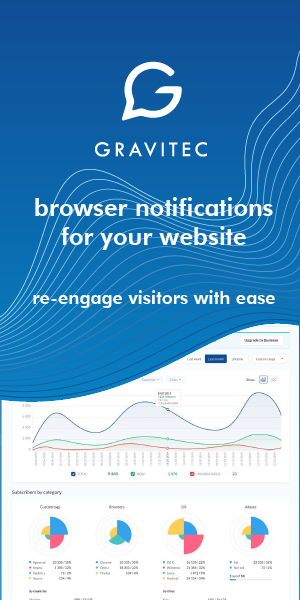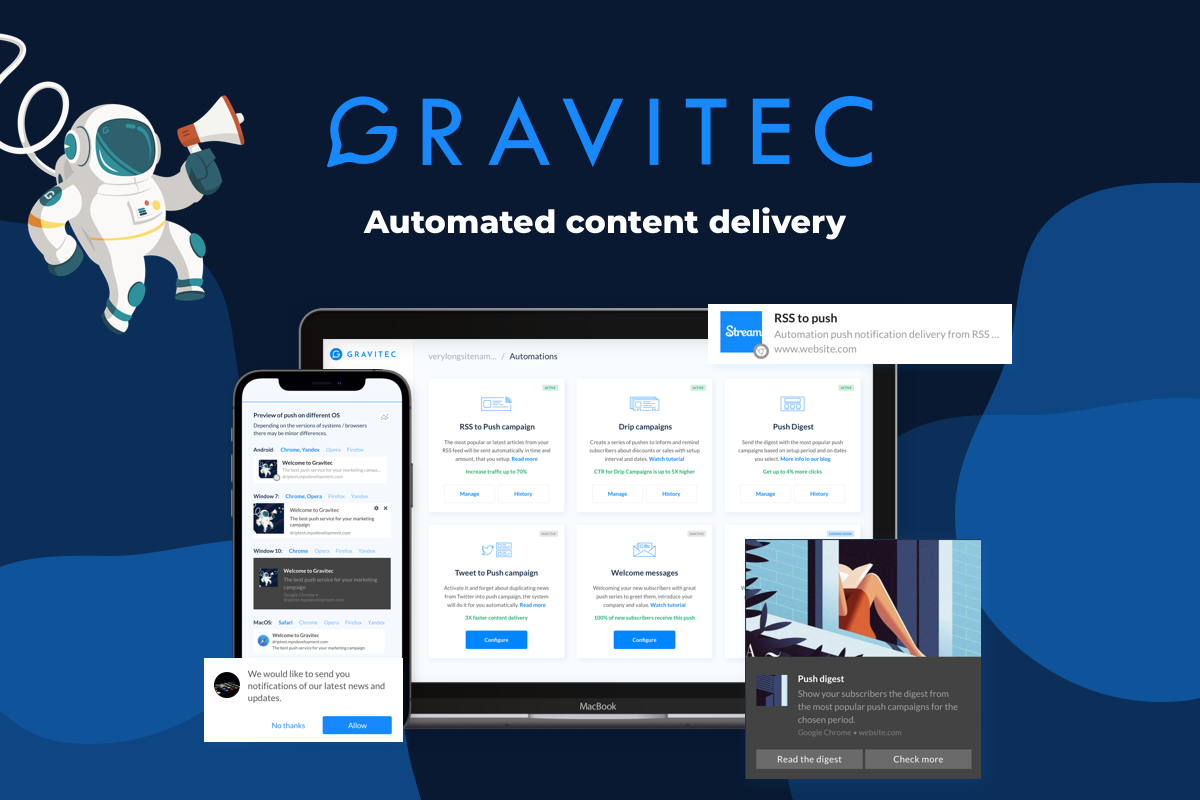Blogging is extremely popular: from 23 blogs for the entire internet in 1999, it came to over 600 million. How do you attract visitors to your blog with so many competitors around? Strategies to create content to make your blog stand out will differ from niche to niche, however, there are things you can do whether you blog about business or cooking: SEO, social media, outreach, and more. Promoting your blog could be difficult, but you’ll handle it with our best tactics.
In this article, you’ll find major strategies to market your blog. If you’re completely new to this, start employing them from the top down, and set some time to see what’s working in your case.
How to market a blog
Once you started a blog, you’d want to find your audience: people to read and share your content or maybe even fellow experts in the niche to create something interesting together. To achieve this, you’ll first need to make sure you’re noticed by the search engines, then you can get on with building relationships with your readers and other blogs. If you need an extra boost, try paid promotions so that you can reach out to the new audience.
Marketing a blog can take multiple forms. We’ll start with a brief list of tactics to help with promoting a WordPress blog or any other.
- SEO. SEO helps you get people to find your blog. It’s the most crucial point you should take care of, as it’s the one that keeps giving. If you optimize your blog to make it more visible, people who search for it will be able to get to your website long after you post the article.
- Email marketing. According to CampaignMonitor, users are 6x times more likely to click the link in your email campaign than a tweet. You can use email to build a relationship with your users, craft newsletters for them, and send special offers. Email marketing comes with a high level of personalization, the ability to include polls to foster conversation, multiple themes, and A/B testing so that you can see what works for your audience.
- Push notifications marketing. Push notifications are another means of communication with your visitors that can be used independently or combined with email.
- Social media marketing. Social media marketing is still a great way to get noticed. Just like any marketing, it requires a strategy in place. Focus on the relevant networks for your blog, vary the message for different networks, and engage with people on those platforms.
- Outreach/Guest blogging/Influencer marketing. Remember that your blog is a part of a niche, so chances are, there are many blogs around that share slightly different perspectives on close topics. Joining forces is beneficial for you and them; also it helps create unique content.
Reaching out to influencers can be very beneficial for blog promotion, as you get to tap into their audience. However, if you don’t aim for paid promotion, you need to build relationships and provide value first, like sharing their content in your blog. Here are the ways to include influencers into your blog promotion strategy:
- Mention influencers in your content
- Ask them for an interview and post it on your blog
- Offer them to contribute to your content; for example, you can make a post on expert advice on how to brew the best Turkish coffee and ask professional baristas for advice.
The guest posting comes with a lot of networking. You reach out to similar blogs in your niche and pitch your post idea. It’s a win-win situation for bloggers, where another blogger gets a well-crafted piece of content for their blog, and you can link to your website. That’s where it gets difficult and time-consuming. You need to spend time reaching out to fellow bloggers, and then you need to create high-quality content.
Another way to promote your blog is to comment on other blogs. Offering your insights can be a way to get noticed by the blog owner and their readers. If your comments are useful and provide additional information, the readers might want to check your blog out, or you might even get an offer to write a guest post. Make sure your content adds information, don’t just go dropping the links to your content; it will only lead to the blog owner’s irritation.
- Paid promotion. Technically speaking, there’s no truly free promotion. Even if you don’t pay for ads, you will invest time in networking, crafting social media posts, and crafting your newsletter. Paid advertising is a way to get results by saving time. You can either go for search advertising or social media advertising.
There are different formats for social media advertising, each catering to different demographics: carousel ads on Instagram, video ads on Facebook, promoted ads on Twitter or sponsored content on LinkedIn. Before you make your choice, consider what social media your audience uses and what type of content do they best respond to. According to the HubSpot’s most recent marketing report, Facebook provides marketers with the highest ROI, however it will be of no use to you if your audience uses TikTok. The costs vary per networks, so you’ll be able to find the option that matches your budget. You can also consider choosing ads on Reddit.
Search ads are displayed in search engine results with an ‘Ad’ icon. Each time someone clicks on your ad, you have to pay a small fee, hence the name PPC (Pay-Per-Click) advertising.
- Content optimization/improvement. There’s more to content than just creating it. If you get back to it, change it or make something new out of it, you’ll have new content that’s way easier to create than starting from scratch.
Once you post some new articles, check if they can be relevant to something you already wrote. Go back to those pieces and add internal links. This way, your readers will stay on your website longer. Google also likes it when your pages contain relevant links from other articles on your blog.
There are multiple ways to get more from the content after you post it:
- Improve your content
- Update your content
- Repurpose your content
Repurposing content means changing your original blog post into a video, infographics, or presentation. For example, if you wrote a blog post on different kinds of coffee beans, you can make an infographic showing their characteristics and matching them to the brewing method that fits best.
SEO to help you promote your blog
SEO is the most crucial strategy to get started, as it helps people find you on their own. There are two main parts to consider:
Technical SEO is concerned with the experience your website creates for the users and whether the browser can find and index your site. It looks intimidating; however, you’ll have this task cut out for you with most website builders. Choose web hosting that offers high speed for your website.
Make sure your blog provides a great page experience for your users. It’s one of the ranking factors of Core Web Vitals.
It takes into account:
- How long it takes your website to show meaningful things
- How long it takes your website when a user does something on your website for the first time, for example, fills in a form.
- Whether your website moves around when it shouldn’t.
On-page SEO deals with the content. If you built your blog on WordPress, you can deal with SEO tasks using WordPress plugins.
To optimize your content for SEO:
- Include keywords on your page. The most important places to include the keywords are page title, main heading, and first paragraph.
- Link to relevant internal pages as well as influential external sites.
- Ask your readers to share your content on their social media pages. Make it easy for them by including social sharing or click to tweet buttons.
If you optimize your blog for search, it’ll let readers organically discover and read your content. You can also let people come to you from social media.
How to promote your blog on social media
Social media is an effective channel for blog promotion. It’s also an easy way to share your content. However, you won’t be able to use it to drive traffic to your blog if you have no online presence. Start with cultivating your social media following. Each social network has its benefits and things to keep in mind.
How to use Twitter to promote your blog? Twitter is the network for communication, where anyone can jump into the conversation and mention your blog. Tag people who might be interested in your content or the ones you mentioned in your blog post, join the conversations. Try different posting schedules to see what works best. Whenever you share a link, describe what it’s about; otherwise, people will be less likely to share it. You don’t have to post a ton of content as long as you incorporate Twitter into your marketing strategy. For example, ask your new email subscribers to follow you on Twitter. Brain Dean from Backlinko reports gaining over 100r followers despite tweeting only once or twice a week.
Tips to share your content on Twitter:
- Share your posts more than once (change the text of the actual tweet or post, though). CoSchedule recommends sharing tweets at publishing, the same day, three days later, two weeks later, and then once in a while.
- Use hashtags to be discovered by a wider audience.
- Use Twitter for A/B testing: share blog posts with different headlines, see what works best on Twitter Analytics.
- Pin important tweets to the top of your feed.
How to promote a blog post on Instagram? Instagram surpassed 1 billion users in 2020, so chances are, your audience uses it as well. If you’re just starting on Instagram, or adding your blog to your personal account, add Instagram icons to your author box, email signature, and other media channels.
Here are some tips on leveraging Instagram for your blog promotion:
- Create visual content. Even if your content has nothing to do with visuals, you can still create images to use with tools like Canva.
- Follow other bloggers and engage with their content. Instagram is first a social media platform, so communicate to become a part of a community.
- Try adding videos to Instagram — they produce 49% more engagement than static images.
- Repurpose your blog articles for Instagram. You can share snippets, turn them into infographics or story cards.
How to promote a blog post on LinkedIn? If you write about topics related to business, consider sharing your posts on LinkedIn. However, just like other social media platforms, LinkedIn hates it when you drive people away from their platform. So, you might be better off republishing your content to your LinkedIn page. Publish it on your blog first, wait a few days until Google indexes it, and republish it to LinkedIn. To avoid confusion for the search engine, add a rel=”canonical” tag to the republished piece of content. To avoid driving readers away from your website, republish only content that doesn’t target keywords you want your website to rank for.
Here are some tips to consider when sharing your posts on social media:
- Find the most optimal times to post.
- Consider creating snippets of content for your social media accounts and then direct people to your blog to get full access.
- Post regularly.
- Add images or GIFs to the posts: images can boost your CTR by 150%.
- Talk to your subscribers and answer their comments.
- Optimize your open graph data so that when users share your content to social media, it looks good.
- Thank readers for sharing.
The only drawback of social media is being a user of their structure. If they decide to delete your account, you won’t be able to retrieve your subscribers, and you’ll have to start from scratch. There are also ways to build your own subscriber list like email and web push notifications.
Promote your blog posts with push notifications
Push notifications efficiently let you connect with your users whether they’re currently on your website or not.  Via tools like Gravitec, push notifications bring users back to your blog, which increases reach. To start getting push notifications, your visitors must opt in first, so you’ll be sending updates from your blog to the interested audience. Push notifications also help you communicate with that portion of users who won’t subscribe to an email newsletter. They also will not be delivered as spam, as your visitor will see their notification next time they’re online. Choose a tool that offers wide customization and automation features.
Via tools like Gravitec, push notifications bring users back to your blog, which increases reach. To start getting push notifications, your visitors must opt in first, so you’ll be sending updates from your blog to the interested audience. Push notifications also help you communicate with that portion of users who won’t subscribe to an email newsletter. They also will not be delivered as spam, as your visitor will see their notification next time they’re online. Choose a tool that offers wide customization and automation features.
Create a free account with Gravitec today
To make the most out of push notifications for your blog:
- Set up an RSS feed so that your readers can follow you using RSS readers like Feedly.
- Set up welcome notifications to give context to all new subscribers.
- Segment and personalize your campaigns
- Create drip campaigns to keep your users engaged
- Automate notifications to let people know there’s new content every time you post
How to promote your blog with email marketing
Email marketing is a powerful tool for building your audience: email shows 42:1 ROI, which means that for every $1 spent, marketers receive $42 back. To start building a newsletter for your blog, add a CTA with a subscription form or a pop-up to your website. This way, you’ll start building the subscriber list you’ll be able to turn one day into your paying customers.
To build your subscriber list, you need to get visitors’ emails. You can add forms to your website, either static forms or pop-ups that come up and attract your visitors’ attention. People might be weary of leaving their personal information, so be sure to offer them something of value in return, like a snippet from your course, a checklist, or a unique video.
Here are tips on making the most from your email marketing:
- Create concise copy for your email
- Write catchy subject lines
- Do A/B testing on copy and subject. The rule of thumb is that if your open rates are low, you need to tweak your subject line, as it’s the first thing the subscriber sees.
- Use buttons to focus readers’ attention.
- Segment your list by activity, for example, people who recently downloaded your PDF.
- Enable social sharing from the email.
- Add links to your post and your blog in the email body and your signature.
There are multiple tools for crafting newsletters like Mailchimp, MailerLite, or Brevo. Choose one that offers automation, has a drag-and-drop editor, and comes with a free plan so that you can experiment before you fully commit to one service.
How to promote your blog by answering questions
Use platforms that answer questions on topics you discuss in your blog, like Quora or Reddit. Look for questions you can answer, and add the link to your blog to provide additional value to the answer. Or you can use Quora to gauge the topics people are interested in and create and share content that covers them. However, don’t just paste the links to your blog instead of an answer; this strategy might get you blocked.
How to use Reddit to promote your blog? Go to Subreddits where people discuss the topics you blog about. Some Subreddits have zero tolerance for spam, so a rule of thumb is to provide relevant content that actually adds to the conversation. Also, make sure to read the subreddit rules, as some subreddits don’t allow self-promotion. However, even if you can’t share a link, you can still answer the question, as it’ll help you build your authority and give you more chances to promote your blog in the future.
You can also go to online forums to promote your blog. It allows you to establish your authority in your niche by posting helpful content. If the forum rules forbid adding links to the posts, you can join in the discussions and add the link to your blog to your profile.
To find forums in your niche, google “intitle:forum” + [your niche keyword]. For example, this is how the search results for people interested in coffee brewing looks. It’s your chance to strike a conversation, even if you blog on a very obscure topic.
Building your brand on forums and social media websites doesn’t happen overnight, usually you’ll need to learn to play the long game. However, if your readers recognize you as an expert, it creates more opportunities for you, for example, you’ll be asked to provide expertise, instead of chasing the outreach opportunities. To make sure your efforts bring results, you need to learn what marketing strategies work.
How to know what’s working from your marketing efforts
The only way to reliably tell whether your promotion techniques are panning out. With an analytic tool, you’ll figure out how people interact with your website, what content they find particularly appealing, and how users got to your website.
Use a web analytics tool, like Google Analytics, to track your traffic. Google Analytics distributes traffic sources into channels according to their rules. In your Acquisition tab, you might see the following traffic sources:
- Direct — visitors typed your address into their address bar or used a bookmark in their browser
- Organic search — visitors come to your website from search engines
- Social — visitors come from social media platforms, for example Instagram or Facebook
- Referral — visitors came from another site by clicking a link
- Paid search — visitors came from paid search ad
- Email — visitors came from links posted in your email campaigns.
- Other or unavailable — traffic that didn’t fit into any of the other categories.
You should also track the reactions to your posts on social media. It will help you figure out the best time to post or the types of content that your audience likes. You can either use native tools on the platform. However, it might get more difficult if you manage multiple social media accounts. In this case, you can try a social media monitoring tool, like Buzzsumo or SEMrush.
Summary
No two blogs are the same, as they work with different niches and audiences. So there can’t be a one-fits-all recipe for promotion. Choose one or two strategies to try and see what works for you. Whatever mix you eventually create will work for your specific blog and help you boost traffic for everything you publish.
Here are ways to promote your blog:
- SEO.
- Email marketing.
- Push notification marketing.
- Social media marketing.
- Paid Promotion.
- Relationship marketing.
- Content optimization.













